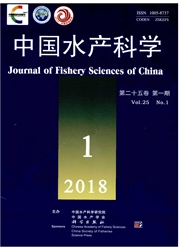

 中文摘要:
中文摘要:
选取体质良好、活力强的大海马(Hippocampus kuda Bleeker),体重(3.075 g±0.16 g)、体全长(11.55 cm±0.31cm)。设置18℃、23℃、28 3℃个实验组和1个对照组(CT组:自然变温),每组3个重复,实验周期28 d。结果显示,大海马在23℃时生长速率最快,摄食活跃;28℃大海马反应最迅速(5.8 s±0.74 s),摄食量最大(153.92 g±10.33 g),活动频繁,泳速大;而18℃和自然变温条件下对食物的反应不敏感,多缠绕在附着物上,摄食时呈聚集式分布;23℃和28℃时,相对活跃,会主动游向饵料摄食,摄食效率较高。综上所述,温度的改变对大海马的生长速率及摄食行为均有一定影响;在适宜温度下,大海马的活力大,摄食量多,生长速率相对较快。本研究旨在为大海马饵料开发和养殖环境优化提供科学数据。
 英文摘要:
英文摘要:
The Hippocampus kuda Bleeker is mainly distributed throughout the tropical and subtropical coastal seas of the Indo-Pacific region. The specie is one of the heavily traded and expensive materials in traditional Chinese medicine(TCM) and has been cultured for generations in public and private aquaria, its conservation status is listed by the International Union for the Conservation of Nature(IUCN) as vulnerable. In order to meet the demand from Chinese traditional medicines, increased trade of seahorses has occurred. However, seahorse culture is a relatively new industry, and many culture problems have been encountered which need to be studied and solved. Feeding behavior is an important index of an animal's suitability to their living environment. Study on the feeding behavior has significance to the strategy of seahorse resource enhancement. In order to provide a theoretical reference for the feeding technology and culturing condition of H. kuda, we examined the effect of varying water temperatures on the growth rate and feeding behavior. The experiment included four different water temperatures(18℃, 23℃, 28℃ and natural temperature CT) in the laboratory for 28 days, with three replicates per treatment. Results revealed that the growth rate was significantly different among the four treatment groups, and the fastest growth appeared at 23℃ treatment. The seahorses feeding behavior was observed more frequently at the treatment of 28℃ as compared with those at other treatments. At 18℃ and CT treatment groups, the seahorses were more entangled in the attachment, clustered distribution and insensitive to food. At 23℃ and 28℃ treatments, seahorses were more sensitivity and more frequently active feeding. In conclusion, variation in water temperature produced significant differences in seahorse growth and feeding behavior. Present study has provided the results that will be useful in rearing.
 同期刊论文项目
同期刊论文项目
 同项目期刊论文
同项目期刊论文
 期刊信息
期刊信息
